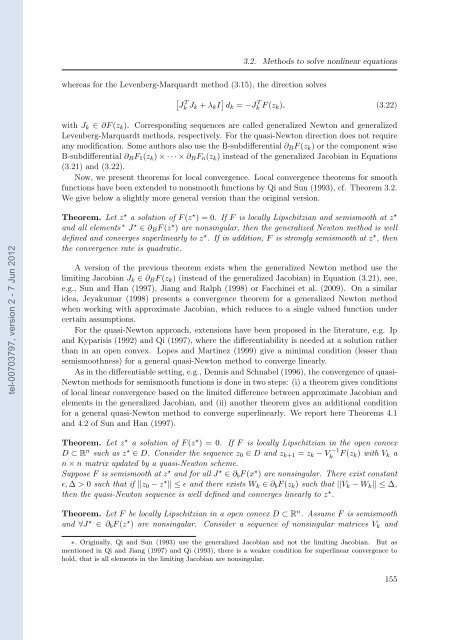Etude des marchés d'assurance non-vie à l'aide d'équilibres de ...
Etude des marchés d'assurance non-vie à l'aide d'équilibres de ...
Etude des marchés d'assurance non-vie à l'aide d'équilibres de ...
You also want an ePaper? Increase the reach of your titles
YUMPU automatically turns print PDFs into web optimized ePapers that Google loves.
tel-00703797, version 2 - 7 Jun 2012<br />
3.2. Methods to solve <strong>non</strong>linear equations<br />
whereas for the Levenberg-Marquardt method (3.15), the direction solves<br />
J T k Jk + λkI dk = −J T k F (zk), (3.22)<br />
with Jk ∈ ∂F (zk). Corresponding sequences are called generalized Newton and generalized<br />
Levenberg-Marquardt methods, respectively. For the quasi-Newton direction does not require<br />
any modification. Some authors also use the B-subdifferential ∂BF (zk) or the component wise<br />
B-subdifferential ∂BF1(zk) × · · · × ∂BFn(zk) instead of the generalized Jacobian in Equations<br />
(3.21) and (3.22).<br />
Now, we present theorems for local convergence. Local convergence theorems for smooth<br />
functions have been exten<strong>de</strong>d to <strong>non</strong>smooth functions by Qi and Sun (1993), cf. Theorem 3.2.<br />
We give below a slightly more general version than the original version.<br />
Theorem. Let z ⋆ a solution of F (z ⋆ ) = 0. If F is locally Lipschitzian and semismooth at z ⋆<br />
and all elements ∗ J ⋆ ∈ ∂BF (z ⋆ ) are <strong>non</strong>singular, then the generalized Newton method is well<br />
<strong>de</strong>fined and converges superlinearly to z ⋆ . If in addition, F is strongly semismooth at z ⋆ , then<br />
the convergence rate is quadratic.<br />
A version of the previous theorem exists when the generalized Newton method use the<br />
limiting Jacobian Jk ∈ ∂BF (zk) (instead of the generalized Jacobian) in Equation (3.21), see,<br />
e.g., Sun and Han (1997), Jiang and Ralph (1998) or Facchinei et al. (2009). On a similar<br />
i<strong>de</strong>a, Jeyakumar (1998) presents a convergence theorem for a generalized Newton method<br />
when working with approximate Jacobian, which reduces to a single valued function un<strong>de</strong>r<br />
certain assumptions.<br />
For the quasi-Newton approach, extensions have been proposed in the literature, e.g. Ip<br />
and Kyparisis (1992) and Qi (1997), where the differentiability is nee<strong>de</strong>d at a solution rather<br />
than in an open convex. Lopes and Martinez (1999) give a minimal condition (lesser than<br />
semismoothness) for a general quasi-Newton method to converge linearly.<br />
As in the differentiable setting, e.g., Dennis and Schnabel (1996), the convergence of quasi-<br />
Newton methods for semismooth functions is done in two steps: (i) a theorem gives conditions<br />
of local linear convergence based on the limited difference between approximate Jacobian and<br />
elements in the generalized Jacobian, and (ii) another theorem gives an additional condition<br />
for a general quasi-Newton method to converge superlinearly. We report here Theorems 4.1<br />
and 4.2 of Sun and Han (1997).<br />
Theorem. Let z ⋆ a solution of F (z ⋆ ) = 0. If F is locally Lipschitzian in the open convex<br />
D ⊂ R n such as z ⋆ ∈ D. Consi<strong>de</strong>r the sequence z0 ∈ D and zk+1 = zk − V −1<br />
k F (zk) with Vk a<br />
n × n matrix updated by a quasi-Newton scheme.<br />
Suppose F is semismooth at z ⋆ and for all J ⋆ ∈ ∂bF (x ⋆ ) are <strong>non</strong>singular. There exist constant<br />
ɛ, ∆ > 0 such that if ||z0 − z ⋆ || ≤ ɛ and there exists Wk ∈ ∂bF (zk) such that ||Vk − Wk|| ≤ ∆,<br />
then the quasi-Newton sequence is well <strong>de</strong>fined and converges linearly to z ⋆ .<br />
Theorem. Let F be locally Lipschitzian in a open convex D ⊂ R n . Assume F is semismooth<br />
and ∀J ⋆ ∈ ∂bF (z ⋆ ) are <strong>non</strong>singular. Consi<strong>de</strong>r a sequence of <strong>non</strong>singular matrices Vk and<br />
∗. Originally, Qi and Sun (1993) use the generalized Jacobian and not the limiting Jacobian. But as<br />
mentioned in Qi and Jiang (1997) and Qi (1993), there is a weaker condition for superlinear convergence to<br />
hold, that is all elements in the limiting Jacobian are <strong>non</strong>singular.<br />
155
















